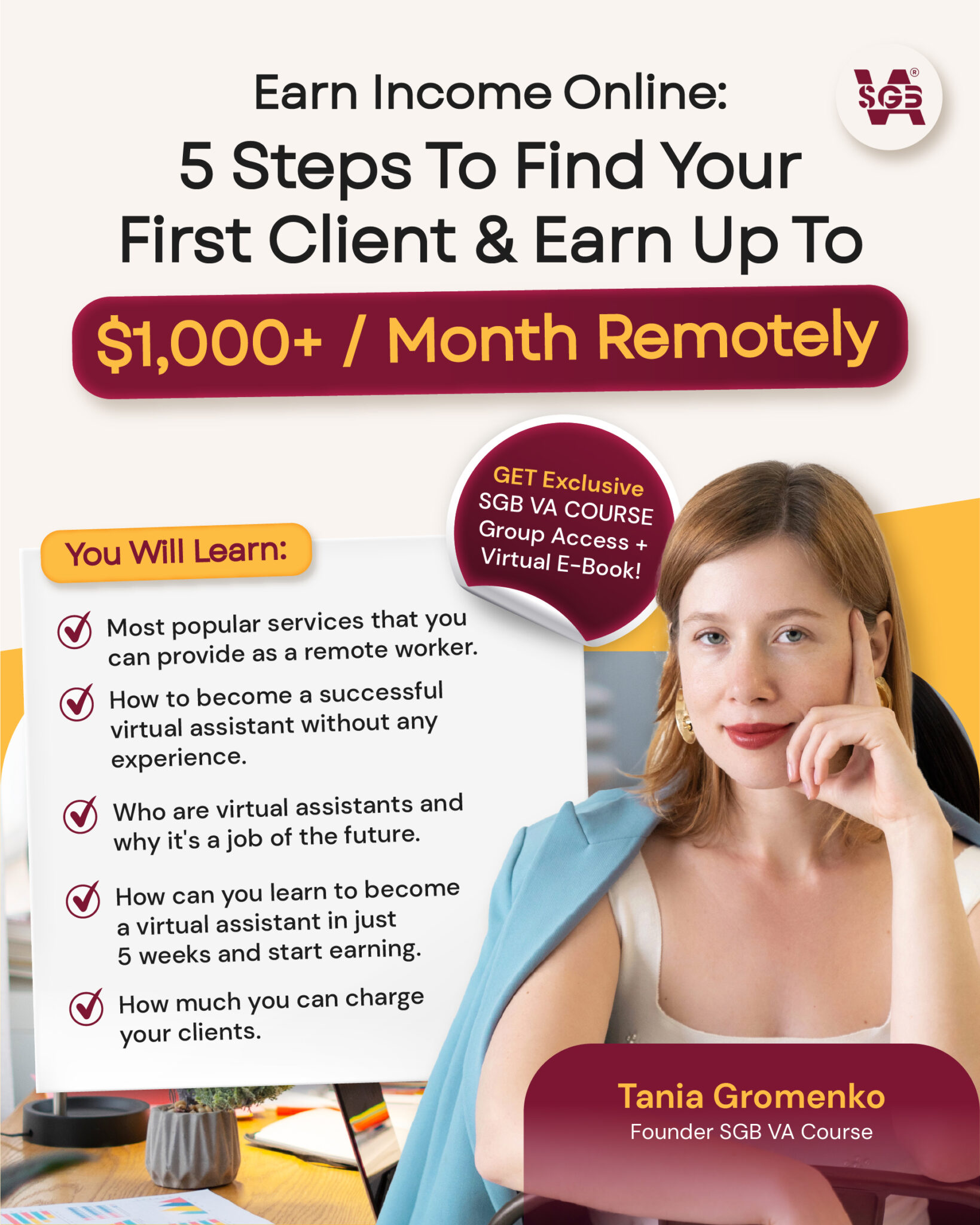Do You Need a Degree to Become a Virtual Assistant?

Do You Need a Degree to Become a Virtual Assistant? Athika Rahma SEO Specialist Virtual Assistant at SGBVA October 29, 2024 Remote Work Tips Becoming a virtual assistant (VA) has quickly become a popular choice for many, from stay-at-home parents and nine-to-fivers seeking a flexible side income, to students and fresh graduates looking for a remote career path. But, do you need a degree to become a virtual assistant? And is formal education or certification essential to kickstart a VA career? This article explores whether you need a degree to succeed as a virtual assistant—and what clients are truly looking for in a VA. In this article… Is Formal Education Necessary to Start as a Virtual Assistant? One of the best things about a career as a VA is its flexibility, making it accessible even to those with little or no formal experience. However, it’s essential to have specific skills to offer clients—because at its core, a VA’s role is about supporting businesses and helping them operate smoothly. But, do you really need a degree? The answer is no! You can start your VA business without one. What matters most is that you develop valuable, marketable skills—whether through traditional education or other means. While a college degree can give you foundational knowledge and skill sets that might support your chosen VA niche, it’s not a hard requirement to become a VA. For many, a degree isn’t an option due to costs, time constraints, or personal commitments. For example, full-time employees or parents often have limited time to attend traditional classes. Fortunately, there are many ways to gain the skills needed for a VA role without investing in a degree. 6 Alternative Ways to Build VA Skills Without a Degree If you’re looking to break into the VA field without a degree, here are some ways to build the essential skills clients seek: 1. Online Courses and Training Programs Many platforms offer specialized VA courses covering time management, communication, and software skills. These courses, like those from SGB VA Course, prepare you for real-world VA tasks. 2. Self-Directed Learning Free online resources, tutorials, webinars, and articles can be excellent tools for skill-building. Self-paced learning lets you focus on areas relevant to your goals, from digital marketing to project management. 3. Gaining Practical Experience You can get hands-on experience through internships, apprenticeships, or volunteering, even if they’re part-time or unpaid. These opportunities allow you to build a portfolio, develop skills, and gain confidence in real-world settings. 4. Networking and Community Engagement Joining online VA communities or forums lets you learn from experienced VAs, get tips, and discover job opportunities. Platforms like LinkedIn and Reddit are great places to start networking. 5. Freelancing Platforms Sites like Upwork and Fiverr offer entry-level projects ideal for new VAs. You can gain experience with simpler tasks, build a client base, and gradually take on more complex projects. 6. Utilizing Transferable Skills Many skills from previous roles, such as customer service, organization, and communication, are valuable in a VA role. Emphasizing these transferable skills can make you a strong candidate without formal VA experience. What Clients Are Really Looking for in a VA Clients often have specific expectations in mind when hiring a virtual assistant, and understanding these can help you stand out. Here are the main qualities that clients typically seek in a VA: Clear Communication Skills Effective communication is key. Clients expect regular updates, transparency on challenges, and steady communication throughout the project. Staying open and proactive helps build trust and makes clients feel engaged and informed. Reliability and Accountability Being dependable is critical for a VA. Clients appreciate VAs who meet deadlines and deliver quality work consistently. Setting realistic milestones and delivering on time can help you build a reputation as a reliable partner. Flexibility and Adaptability Business needs are constantly evolving, so clients look for VAs who can adjust to changing priorities and unexpected challenges. This flexibility shows you’re committed to helping clients reach their goals, even in dynamic situations. Proficiency in Relevant Skills Clients seek VAs with the specific skills they need, whether that’s administrative support, social media management, or tech support. The more proficient you are in these areas, the better you’ll be at handling various tasks and offering innovative solutions. Proactive Problem-Solving Clients value VAs who don’t wait around for instructions but can solve problems independently. This proactive approach helps boost productivity and reassures clients that you’re capable and confident in managing projects. Cultural Fit and Understanding A strong understanding of a client’s business culture can make a big difference. Clients appreciate VAs who can align with their work style and values, as it fosters smoother collaboration and enhances trust. Openness to Feedback Constructive feedback is a two-way street. Clients expect VAs to be open to improvement and, in turn, often welcome insights on how their processes impact your work. This mutual feedback strengthens the relationship over time. Successful VA Businesses Without a Degree If you’re still unsure whether a degree is essential for becoming a virtual assistant, you might be inspired by the stories of VAs who’ve successfully built thriving businesses without one. In the SGB VA alumni hub, many virtual assistants have proven that with dedication, skill-building, and the right mindset, you can achieve success and secure clients from around the world—even without a degree. These VAs come from all walks of life. Some are parents balancing family with work, others are career-switchers who left traditional jobs for the flexibility of a VA business, and many started with little to no professional experience. Each was able to launch a VA business and build a client base in regions like Indonesia, Singapore, Australia, the UK, and even the US. You can read their inspiring journeys in our alumni stories section to discover how they started, the challenges they overcame, and the unique paths they took to success! So, Is a Degree Necessary for a VA Career? Now that you know what clients expect and how to gain essential
How to Get Clients as Virtual Assistant in 2024

How to Get Clients as a Virtual Assistant in 2025 Athika Rahma SEO Specialist Virtual Assistant at SGBVA October 26, 2024 Remote Work Tips Finding clients is one of the most challenging steps to becoming a successful virtual assistant (VA). You need to put in significant effort to make potential clients recognize your value and want to hire you. While it may seem difficult at first, it is absolutely achievable. Often, the initial challenges are the toughest; however, as you gain more clients, new opportunities will naturally come your way! So, how to get clients as a virtual assistant exactly? Prepare yourself and read on to learn more! In this article… What to Prepare Before you can successfully attract clients as a virtual assistant, it’s crucial to prepare yourself effectively. Here are some key elements to focus on: Establish a strong VA brand. Your brand identity is crucial for how potential clients perceive you. Develop a cohesive and professional presence across social media, including a consistent color scheme. A strong brand helps you stand out and instills confidence in clients. Create a compelling portfolio. Your portfolio showcases your skills and past work. Highlight successful projects with quantifiable results, such as “Increased sales by 150% in one month.” This evidence makes your capabilities tangible and appealing to potential clients. Craft a great pitching message. When reaching out to clients, your pitch should be concise and tailored to their needs. Clearly articulate how your skills can address their specific challenges. A well-crafted message demonstrates your understanding of their situation and readiness to help. Maintain an active social media presence. An active social media account boosts your online visibility. Regularly post updates, share insights, and engage with your audience. This shows your expertise and commitment to your business, signaling to potential clients that you are engaged and up-to-date with industry trends. How to Get Clients as a VA in 6 Ways Finding clients as a virtual assistant can feel a bit overwhelming at first, but don’t worry—there are plenty of effective strategies to help you connect with potential clients. Let’s dive into six practical ways you can get started! 1. Reach Out to Friends and Family Don’t overlook your personal network! Friends and family often need help with daily tasks or their businesses. Let them know about your services and ask if they or someone they know could use your assistance. 2. Explore Freelance Job Boards and Social Media Groups Actively search for VA opportunities on freelance job boards and in social media groups dedicated to virtual assistance. Regularly check these platforms and apply for jobs that match your skills and interests. 3. Attend Networking Events Networking is a powerful way to meet potential clients and other professionals in your field. Attend industry events, workshops, or online webinars to expand your network. Building relationships in these settings can lead to new opportunities and referrals. 4. Focus Your Branding on One Social Platform Choose a primary social media platform that aligns with your target audience and concentrate your branding efforts there. For example, if you’re targeting executives, LinkedIn is ideal. If your focus is on small and medium enterprises (SMEs), consider platforms like Instagram or TikTok to showcase your services creatively. 5. Connect with Other VAs Building relationships with other virtual assistants in your niche can be mutually beneficial. Offer your assistance on tasks they might be overwhelmed with, and you’ll foster a sense of community. Collaborating with peers can lead to referrals and shared opportunities. 6. Offer Free Consultations Providing free consultations is a great way to showcase your expertise and build rapport with potential clients. Use this opportunity to understand their needs better and demonstrate how your services can help them achieve their goals. Crafting an Engaging Pitch for Potential Clients Creating an effective pitch is essential for converting potential clients into long-term partners. Start with a strong hook that captures their attention. For instance, ask a compelling question like, “Are you struggling to keep up with daily tasks while trying to grow your business?” This shows you understand their challenges right from the start. Next, introduce yourself confidently. Share your background and relevant experience to establish credibility. Highlight your unique strengths and skills, providing specific examples of how you’ve helped others achieve results. For instance, mention how you managed a project that increased client engagement by 40% in just three months. Finally, end with a clear call to action. Encourage them to take the next step, whether it’s scheduling a meeting or visiting your website. Unlock Strategies for Landing Clients Your journey to acquire clients as a virtual assistant will be much easier with the right support and guidance from the very beginning. That’s why the SGB VA course should be a part of your journey! With an enhanced curriculum, we will assist you from the initial steps of creating your VA business all the way to landing your first client. If you want to learn more about the course, join our free webinar with Tania Gromenko, a VA expert who will share her insights on building a successful VA career. Register now by clicking the link below! Build Successful VA Career Now Start a career as a virtual assistant with the insights from our mentor, Tania Gromenko.Click the button and register right now! Register Free Webinar Explore Paid Course
What Not to Do as Virtual Assistant: 10 Common Mistakes to Avoid

What Not to Do as Virtual Assistant: 10 Common Mistakes to Avoid Athika Rahma SEO Specialist Virtual Assistant at SGBVA October 25, 2024 Remote Work Tips If you’re an office worker, a new mom, or even a student starting your career as a virtual assistant, there’s a good chance you’ll make a few small mistakes along the way. That’s completely normal, as you’re embarking on a new chapter in your life. However, it’s helpful to be aware of certain pitfalls that could hinder your career. So, what not to do as a virtual assistant? Here are 10 common mistakes you should know about. In this article… 1. Starting with the Wrong Mindset Let’s get real: the idea that clients will just come knocking on your door without any effort is a myth. Many new VAs start off with a dreamy vision of a steady stream of clients, only to feel frustrated when it doesn’t happen. The truth is, building a client base takes work. You need to actively seek out opportunities, pitch your services, and connect with potential clients. Embrace the hustle! Consider it a business, where effort and strategy matter. Adopting a growth mindset is crucial—view challenges as learning experiences rather than setbacks. 2. Not Investing in Knowledge If you think you can rely on your existing skills forever, think again! The virtual assistance landscape is always evolving, and clients expect you to stay current. Neglecting to invest in your professional development can leave you behind the curve. This doesn’t just mean taking expensive courses—look for webinars, like SGB VA free VA webinar, podcasts, and online resources that can expand your knowledge. Set aside some time each week for learning. Think of it as an investment in your future: the more you know, the more valuable you become to your clients. 3. Mispricing Your Services Ah, pricing—one of the trickiest parts of being a VA. Many newcomers either undercharge out of fear that they won’t attract clients or overcharge because they overestimate their worth. Finding the right pricing as a VA is essential. Start by researching what other VAs in your niche are charging. Consider your skills, experience, and the complexity of the services you provide. Remember, pricing too low can lead to burnout, while pricing too high without justification can scare clients away. It’s all about finding that sweet spot that reflects your value while remaining competitive. 4. Being Vague About Pricing Clarity is key when it comes to pricing your services. If potential clients can’t easily find out what you charge or what’s included in your services, they may hesitate to reach out. Create a clear pricing structure and make it accessible on your website or social media profiles. Whether you charge by the hour, project, or retainer, communicate it upfront. Transparency helps build trust and allows clients to make informed decisions. Plus, it prevents awkward conversations about money later on! 5. Lacking Brand Identity If you don’t establish a strong brand identity, it’s easy to get lost in a sea of virtual assistants. Take some time to define what sets you apart. What are your core values? What services do you specialize in? Create a cohesive visual identity—think logo, color scheme, and fonts—and use them consistently across your social media and marketing materials. Your brand should resonate with your target audience and reflect your personality. A strong brand identity helps clients remember you and can lead to referrals down the line. 6. Assuming It’s Easy It’s common to think that being a virtual assistant is an easy gig, but every job comes with its challenges. Many VAs quickly realize that there’s much more to it than just completing tasks. Expect to face obstacles, whether it’s managing difficult clients, meeting tight deadlines, or navigating technology issues. Embrace these challenges as part of the learning process. Recognize that success takes time and effort, and don’t be discouraged by setbacks. The more resilient you are, the more successful you’ll become. 7. Expecting Fast Earnings Jumping into virtual assistance with the belief that you’ll make quick money can lead to disappointment. While some VAs might land clients quickly, for many, it takes time to build a sustainable income. Focus on the long game—cultivating relationships, delivering quality work, and consistently marketing yourself. Set realistic expectations for your earnings and understand that success often builds gradually. Celebrate small wins along the way, as they’ll pave the path to long-term success. 8. Treating Clients as Bosses Here’s a game-changing perspective: your clients should be your partners, not your bosses. It’s tempting to go along with everything they say, but that can lead to a one-sided dynamic. Remember, you’re bringing your expertise to the table! Don’t hesitate to express your thoughts or provide suggestions when appropriate. A collaborative approach fosters mutual respect and often leads to better outcomes for both parties. Building strong partnerships can also lead to repeat business and referrals. 9. Not Setting Boundaries Are you the type who says “yes” to every request, even when you’re overwhelmed? It’s easy to fall into that trap, but it can lead to burnout and resentment. Setting boundaries is crucial for your well-being. Communicate your availability clearly to clients and stick to it. This not only helps you manage your workload but also sets expectations for your clients. Don’t be afraid to take time off when you need it. A well-rested VA is a more productive VA! 10. Inadequate Communication Good communication is the backbone of any successful client relationship. If you often leave messages unread or fail to keep clients updated on project progress, it can create frustration and distrust. Make it a habit to check in regularly, even if it’s just to provide a quick status update. Keep your clients informed about any challenges or urgent issues that arise. Open and honest communication builds trust and helps you maintain a strong working relationship. Remember, your clients appreciate being kept in the loop! Minimize Mistakes, Maximize Success as a VA If you want
What Is The First Step of Becoming a Virtual Assistant?

What Is The First Step of Becoming a Virtual Assistant? Athika Rahma SEO Specialist Virtual Assistant at SGBVA October 22, 2024 Remote Work Tips More and more people are aspiring to become virtual assistants (VAs). In today’s economy, working remotely has become not just a trend, but a viable and exciting option. It offers the freedom to work from anywhere, at any time, while also providing the potential to earn more than traditional office jobs. But let’s be honest, starting something new is never easy. Sometimes, we feel uncertain about what the first step to become a virtual assistant should be, or we lack the courage and motivation to take that leap. If that sounds like you, don’t worry—this guide is here to help you clear up the confusion and boost your confidence! In this article… Determine If It’s the Right Career for You Before diving in, it’s important to figure out if becoming a virtual assistant is the right career for you. Many people suggest picking a skill or niche to focus on, but the very first step of becoming a VA is to assess whether this career path aligns with your personality, strengths, and lifestyle. To help you decide, ask yourself these questions: Am I organized and detail-oriented? Do I have good communication skills? Am I tech-savvy and comfortable using online tools (like email, calendar apps, or project management software)? Am I self-motivated and disciplined? Can I work independently and manage my time well? Am I okay with having a flexible work schedule? Can I handle working outside of regular hours when needed? Do I enjoy taking the initiative and helping others succeed? Can I handle variable income? Am I financially prepared for periods when work may be light? Do I have a dedicated workspace? Am I open to continuous learning and upgrading my skills? Am I ready to be a business owner? If you find that 80% of your answers are “yes,” you’re likely on the right track toward becoming a VA. But even if you answered “no” to some of these questions, don’t worry! If you’re willing to adapt and grow into the role, a career as a virtual assistant is still very much within reach. A career transition is always possible, no matter where you’re starting from. Identify Your Strengths Once you’ve decided that becoming a VA is the right fit for you, the next step is to identify the strengths that will help you succeed. These can be broken down into hard skills, soft skills, and equipment. Hard skills are the technical abilities you’ve gained through education or experience. For example, if you’re great at data entry, social media management, content writing, or bookkeeping, these are all valuable hard skills that can help businesses streamline their operations. Familiarity with software tools like Google Workspace, Microsoft Office, Trello, Zoom, or Canva is also crucial. Soft skills are personal traits that influence how you work and interact with others. Things like time management, organization, adaptability, communication, and problem-solving are essential for a VA. These skills will help you work independently, build strong relationships with clients, and handle tasks with professionalism. Equipment refers to the physical and digital tools you need to perform your job efficiently. As a VA, you’ll need a reliable laptop or computer, a stable internet connection, a headset or microphone for clear communication, and the right software to collaborate with clients. For instance, if you want to specialize in graphic design, you’ll need graphic design skills (hard skills), the ability to work independently (soft skills), and equipment like an iPad Pro for designing. Alternatively, if you want to focus on email marketing, you’ll need digital marketing skills, strong communication and time-management skills, and a computer capable of handling email campaigns smoothly. Each VA role is different, and the specific mix of skills and equipment will vary based on the services you offer. Pick Your Niche and Services Now that you’ve identified your strengths, it’s time to define your niche and services. Specializing in a specific area will help you stand out in a crowded marketplace. Popular VA niches include: Administrative tasks (calendar management, email handling, research) Social Media Management Bookkeeping and Financial Support Customer Service Content Creation Digital Marketing Once you’ve chosen your niche, you can start defining the specific services you’ll offer. Whether it’s email management, social media support, content creation, or research, having a clear set of services will help you attract the right clients. Starting with a focused service offering allows you to build credibility and expertise, and as you grow, you can expand your services to meet more complex needs. Here are some common VA services: Calendar and email management Data entry and research Travel booking and coordination Document preparation (reports, presentations) Blog writing, newsletter creation, and SEO optimization Social media management and ad campaigns Email marketing Determine Your Service Price Now that you know your strengths and services, it’s time to set your pricing. Pricing can be tricky for many new VAs. You might worry that charging too much will scare off clients, but pricing yourself too low can lead to undervaluing your skills and services. It’s important to strike the right balance. You want to charge enough to reflect the value you bring to the table, but not so much that you price yourself out of potential clients. Don’t stress too much about it—pricing is something that you can adjust over time as you gain more experience and confidence. We’ve also put together a full guide on how to calculate your service fees, so you can find the pricing strategy that works best for you and your business. Brand and Market Yourself Now that you’ve worked through the first step to become virtual assistant—defining your niche, identifying your strengths, and setting your price—it’s time to market yourself as a VA. Start by joining freelancing platforms like Upwork, Fiverr, or Freelancer to connect with clients who are looking for virtual assistants. For more VA-specific opportunities, check out
Social Media Virtual Assistant: Skills, Tools and Salary in 2024

Social Media Virtual Assistant: Job Description, Skills, and Salary in 2025 Athika Rahma SEO Specialist Virtual Assistant at SGBVA October 22, 2024 Remote Work Tips Are you passionate about social media? Do you stay updated on the latest trends, enjoy browsing for content ideas, and love engaging with others online? If so, offering social media virtual assistant services could be a fantastic opportunity for you! Not only will you get to do what you love, but you can also work fully remotely without the need to go into an office. Many industries, companies, and personal coaches rely on social media to enhance their business visibility. If you aspire to become a social media VA, this guide will provide you with a clear path to get started. In this article… What is a Social Media Virtual Assistant? Let’s begin by defining what a virtual assistant (VA) is. A Virtual assistant is a remote worker who provides administrative, technical, or creative assistance to clients, either part-time or full-time. VAs offer their expertise to help businesses meet their operational needs. Social media is one of the services a VA can offer, whether for individual coaches, small and medium-sized business owners (SMEs), or even CEOs of large companies. A social media VA can manage business and personal accounts for business owners, depending on the client’s needs. Social Media VA Job Description Here are some typical tasks a social media VA can handle: Managing multiple social media accounts: A social media VA takes care of tasks such as responding to comments, engaging with followers, posting content, and organizing the posting schedule. You will ensure that everything runs smoothly and efficiently, allowing business owners to focus on other important areas. Targeting and engaging audience: Small businesses often have a specific target audience, and a social media VA helps by crafting campaigns tailored to that niche. Instead of using generic content, you will develop strategies to engage the right audience and make a meaningful impact. Optimizing post scheduling for better reach: Social media VAs use tools like Hootsuite or other scheduling platforms to plan posts strategically. This ensures maximum engagement by posting at optimal times when your audience is most active. Managing follow-ups and lead generation: Social media platforms are valuable tools for generating leads, but following up on those leads is just as important. A social media VA helps manage follow-ups, including email communication, ensuring no opportunities are missed. Skills Needed to Become a Social Media VA You don’t need specific experience or a degree to become a social media VA, as this field can be learned through courses or self-study. However, to increase your chances of being hired, you should possess the following skills: Advanced Communication Skills: Effective communication, including flawless grammar and persuasive messaging, is essential for engaging with audiences online. Organizational Skills: High levels of organization are crucial for managing multiple projects and ensuring deadlines are met. Basic IT Knowledge: Proficiency in tools like Microsoft Office, project management software (e.g., Trello, Asana), and social media automation tools. Time Management: Self-motivation and discipline are key to working independently, requiring strong time management techniques. Content Creation and Design: Skills in copywriting and graphic design are critical for creating engaging content and visuals. Research Abilities: Thorough research helps you understand target audiences and develop effective content strategies. Adaptability and Versatility: The ability to adjust to different platforms and client needs is vital, especially as trends and tools evolve. Analytical Skills: Understanding how to measure social media campaign performance and adjust strategies accordingly is essential. Social Media VA Tools There are some tools that can make the job easier for social media VAs: Hootsuite: A popular tool for managing multiple social media platforms, allowing you to schedule posts and track performance. Canva: A user-friendly design tool that helps create engaging social media graphics. Likeable Hub: A tool that integrates with Facebook, LinkedIn, and Twitter, providing scheduling and analytics. Tweetdeck: Ideal for managing Twitter accounts, this tool helps schedule posts and monitor activity. Zoom: A widely-used video conferencing tool for virtual meetings with clients or teams. Slack: A communication platform that streamlines collaboration and project discussions. And many more! How Much Does a Social Media Virtual Assistant Make? Social media virtual assistants are in high demand, and according to The Business Research Company, the social media market is expected to grow by 14.8% in 2024, reaching $251.45 billion. This means more job opportunities for VAs specializing in social media! But, how much can a social media VA earn? According to ZipRecruiter, social media VAs in the United States charge an average of $24 per hour. You can adjust your pricing based on your country and experience level. For beginners, starting with a lower rate and gradually increasing it as you gain skills and experience is common practice. Additionally, you can create custom pricing packages depending on the client’s needs. We’ve seen VAs earn between $500 to $1,500 per social media management package! If you’re unsure how to set your rates, check out our article on how to calculate your Minimum Acceptable Rate (MAR) based on your location, services, and expertise. How to Start a Social Media VA Business If you’re already engaged on social media, meet the necessary job requirements, and recognize the potential in this field, now is the perfect time to kickstart your career as a social media VA! Here’s how: Develop your social media skills by reading articles, watching videos, or taking some courses. Get the essential tools; a laptop and smartphone are a must for a smooth workflow. Install and familiarize yourself with social media tools. Create your own social media accounts and post regularly to build your brand. Prepare your CV and portfolio. Apply for social media VA jobs through virtual assistant job portals. Pitch directly to potential clients via social media. Stay consistent until you land your first client! These steps will help you start your journey, but continuous learning and persistence are key to long-term success. If you need extra
7 Platforms to Find Virtual Assistant Jobs for Beginner

7 Platforms to Find Virtual Assistant Jobs for Beginner + How to Use Them Athika Rahma SEO Specialist Virtual Assistant at SGBVA October 19, 2024 Remote Work Tips If you’re a beginner looking for virtual assistant jobs, you know how frustrating it can be to find the right opportunity. You may have applied to countless positions without hearing back, or even reached out to business owners directly with no success. But don’t get discouraged just yet. What you might need is a platform dedicated specifically to virtual assistant jobs for beginner. In this article, we’ll introduce you to 7 platforms designed to help you find the perfect virtual assistant role. Keep reading to discover more from SGB VA! Table of Contents 1. LinkedIn LinkedIn is one of the largest job portals in the world. From full-time jobs to freelance gigs and virtual assistant roles, LinkedIn offers hundreds of new opportunities across various categories. More than that, LinkedIn is also a social media platform, meaning you can post about your achievements, perspectives, and more, while connecting with other professionals, which can improve your chances of getting hired. Here are some ways to use LinkedIn to find virtual assistant jobs: Go to the LinkedIn search bar and type “virtual assistant” as a keyword. Select “Jobs” and adjust your location to “Worldwide” to see opportunities from all around the globe. Instead of selecting “Jobs,” choose “Posts” after typing “virtual assistant” in the search bar. This can lead to posts where people share job opportunities. It may take more effort, but you might just find a hidden gem! Join virtual assistant groups like “The Virtual Assistant Networking Association” or “The Virtual Assistant Network” to discover even more job opportunities. Group admins typically ask for a short form explaining why you want to join. If you’re a VA looking for work, you’ll likely be accepted! Directly reach out to business owners. Many CEOs use LinkedIn, so why not pitch your services? However, it’s better to connect and engage with them first, learn about their business, and then softly introduce how you can help. 2. Upwork Upwork is another popular platform for find virtual assistant jobs for beginner. There are tons of jobs posted directly by clients, many of which are beginner-friendly and don’t require much experience. Tasks like data entry, customer service, appointment setting, bookkeeping, and research are common here. Here’s how Upwork works: When a job is posted, you can submit a proposal explaining your services, your rates, and what sets you apart. It’s helpful to showcase testimonials or certifications if you’re a beginner to prove your expertise. However, Upwork isn’t completely free. You’ll need “Connects” to apply for jobs, and while you get some free Connects upon joining, you may need to upgrade to Freelancer Plus (US$14.99/month) for more. Upwork also takes a 10% fee from your earnings unless you’re a Freelancer Plus member. 3. Facebook If you’re still using Facebook mainly for fun, it’s time to leverage it for job hunting! Facebook allows you to connect with others and share content, but it also has active job-related groups. Using Facebook to find virtual assistant jobs is simple and effective. One of the best ways to start is by joining dedicated groups where job postings are shared frequently. For example, groups like “I Need a Virtual Assistant” (with 19.5K members) and “Virtual Assistant Jobs” (with 286K members) regularly feature job openings from companies and direct clients. Also, you can use Facebook’s Jobs feature. Navigate to the Jobs section on Facebook, and then you can search for “virtual assistant” roles, filter by remote positions, and find postings that match your skills. 4. VirtualVocations.com VirtualVocations is a job portal that offers various remote positions, including virtual assistant roles. You can easily find VA jobs by typing the keyword in the search bar. There are many categories, such as Admin VA, Sales VA, Medical VA, and Call Center VA. Many of these roles are entry-level, meaning you can apply even without prior experience. Just sign up, complete your profile, and apply for jobs that match your skills. Registration is free, and you can access their job database as much as you want. 5. Timeetc Timeetc is a talent pool that connects virtual assistants with clients in need of administrative help. It’s essentially an agency for virtual assistants. This platform is great for those looking for part-time admin work since the majority of opportunities involve helping with administrative tasks. To apply, visit their website, navigate to the “Work for Us” section, and sign up. Keep in mind that this site mainly offers part-time roles, so it may not be ideal if you’re seeking full-time work. 6. Assistant Match Assistant Match is a great platform that provide virtual assistants jobs for beginner. This agency helps match virtual assistants with clients based on their specific skills and experience. After signing up, you’ll receive job offers tailored to your abilities, which means you’re more likely to get matched with jobs that suit your strengths. Most of the opportunities on Assistant Match are related to administrative tasks such as typing, data entry, email management, and scheduling. If you have basic administrative skills or experience, this platform can be an excellent starting point for building your virtual assistant career. Assistant Match also offers ongoing support to help you succeed, making it a reliable option for beginners. 7. Clickworker Have you ever heard about Clickworker? Clickworker is ideal if you prefer flexibility and working on smaller, quick tasks. Unlike traditional virtual assistant roles that require long hours, Clickworker offers microtasks—these are small tasks like data entry, filling out surveys, AI training, voice recordings, and even participating in photo contests. These tasks may seem simple, but they can pay well, especially if you complete multiple tasks efficiently. Some users report earning between US$6 to US$40 per hour (according to Quora), depending on the type of task and how many you complete. This platform is perfect if you want to earn extra income on
10 Part-Time Virtual Assistant Jobs for Student, Moms, and Full Time Workers

10 Part-Time Virtual Assistant Jobs for Student, Moms, and Full-Time Workers Athika Rahma SEO Specialist Virtual Assistant at SGBVA October 18, 2024 Remote Work Tips Are you a student seeking extra income to support your studies? A mom balancing family responsibilities but still wanting to earn money? Or a full-time worker looking to boost your income through side gigs? Consider becoming a part-time virtual assistant! As the name suggests, these roles typically require only 10 to 20 hours of work per week. If you’re interested in exploring part-time virtual assistant jobs, read SGBVA’s comprehensive guide below. Table of Contents 1. Email and Calendar Management An email and calendar management VA handles incoming and outgoing emails, filters out spam, drafts responses, maintains organized folders, and sets up automated replies. As an email and calendar manager, you can earn from $10 per hour. Why is this part-time? Managing email and calendar correspondence, which is also part of administrative tasks, can be scheduled flexibly. You can dedicate evenings or weekends to responding to emails, making it a great fit for a part-time schedule. 2. Data Entry A data entry VA is responsible for entering new database records, verifying accuracy, adhering to formats, and performing periodic updates. This is one of the easiest virtual assistant jobs, requiring minimal experience or education. You can earn from $18 per hour with this task. Why this can be done part-time? Routine data entry tasks can be completed in batches, making it ideal for part-time work due to its predictable nature. 3. Customer Service Did you know that customer service can be a part-time job too? As a customer service VA, you will answer FAQs via phone calls, chats, or emails, provide product demos, escalate unresolved issues, and maintain a professional demeanor. You can earn from $18.8 per hour in this role. While part-time customer service jobs may require you to be available during specific hours, they typically require only 2 to 4 hours of work per day. 4. Travel Arrangements Have you heard of travel arrangement VA tasks? This popular role involves booking flights, hotels, and arranging travel logistics based on client needs. You can earn from $10 per hour with this task. Why is it doable part-time? Travel planning often involves research that can be done ahead of time, allowing for breaks between tasks. It doesn’t require constant attention, so you can work whenever it suits you! 5. Content Creation Content creator VAs often work on clients’ blogs or websites (as Content Writer VAs) and manage social media (as Social Media Management VAs or Copywriter VAs). This role involves writing articles, blog posts, or social media updates, engaging audiences, and maintaining brand voice consistency. Typically, you can earn from $25 to $31 per hour in this field. What makes it manageable part-time? Content creation can be done sporadically. While some tasks may have deadlines, much of the work can be completed independently at any time, making it adaptable to part-time schedules. 6. Bookkeeping Services Bookkeeper VAs manage financial records, document transactions, oversee accounts payable and receivable, handle invoices, and calculate business profits. The complexity of this work depends on the client and the size of their company. Typically, bookkeeper VAs can earn from $19 to $24 per hour. Why is it part-time friendly? These tasks can be performed regularly without requiring continuous daily involvement, allowing you to adjust your schedule as needed. 7. Event Planning Event planning involves coordinating details, sending invitations, and confirming attendees. You can earn from $30 per hour in this role. Much of the planning can be done asynchronously, accommodating part-time availability. 8. Research Assistant As a research assistant, you will conduct research on various topics, collect and analyze data, summarize findings, and assist in market research or academic projects as needed. You can earn from $22 per hour in this position. Research tasks can be completed in segments, allowing for focused work periods that fit around other commitments. This role often requires independent work that can be done at any time. 9. Graphic Design Graphic design VAs create visual content for marketing materials, social media posts, websites, and presentations. You can earn from $19 per hour by editing images and designing graphics to enhance brand visibility. Graphic design projects can often be completed on a freelance basis with clear deadlines, allowing designers to work at their own pace, making it suitable for part-time schedules. 10. Online Community Management Manage online communities or forums by engaging with members, moderating discussions, responding to inquiries, and creating content to stimulate conversation while maintaining a positive environment. You can earn from $40 per hour in this role! Community management can be done at various times throughout the day, allowing for flexible engagement based on your availability. This position typically requires only periodic attention rather than continuous oversight. Kickstart Your Part-Time VA Job With these part-time virtual assistant jobs, you can earn extra income while enjoying your free time. If you’re interested in getting started but still feel confused, gain insights from SGBVA free webinar. Our mentor, Tania Gromenko, will share: How to kickstart your VA career The types of services you can provide as a VA How to become a successful VA in just five weeks! Register now to receive a FREE e-book titled “FAQ About Virtual Assistants” and exclusive access to the SGBVA virtual assistant community on Telegram. Click to the button below! Register FREE Webinar Alongside our mentor, Tania Gromeko, you will receive guidance to start a career as a virtual assistant, handling various part-time jobs. Click the button and register now! Join Free Webinar Explore Paid Course
Admin Virtual Assistant: Simplest Way to Become a Remote Worker

Admin Virtual Assistant: Simplest Way to Become a Remote Worker Oni Lestari Virtual assistant, copywriter, SEO-expert October 17, 2024 | Remote Work Tips Ever wondered what it feels like to work from home or sit in the corner of your favorite café, far away from traffic jams and office drama? The world of remote work makes that dream a reality. But what kind of jobs can you do remotely? Believe it or not, the answer might lie in skills you already use daily: administrative tasks! With these skills, you have the opportunity to become a virtual assistant (VA), helping business owners tackle their administrative challenges. How do you find and land remote admin jobs? Check out the explanation in the following article! Table of Contents: Why Admin Tasks Are Beginner Friendly? You might think that admin tasks are just about replying to emails or filling out documents. But in reality, this role is so much more! Well-executed administrative tasks can keep a business running smoothly. From managing client schedules and handling emails to ensuring all the business owner’s tasks are completed efficiently—when admin work is done right, business owners can focus on more strategic responsibilities. Starting a career as an Admin VA is a great first step, especially if you’re new to the world of remote work. Here are two main reasons why remote admin jobs are perfect for beginner VAs: 1. Easy to Start Sebagian besar tugas administratif tidak memerlukan sertifikasi khusus atau pengalaman bertahun-tahun. Banyak keterampilan dasar yang sudah sering kamu gunakan dalam kehidupan sehari-hari, seperti mengatur jadwal, mengelola email, atau membuat daftar tugas. Keterampilan ini adalah fondasi penting untuk menjadi seorang Admin VA. Yang paling dibutuhkan adalah kemampuan mengatur waktu, perhatian pada detail, dan kenyamanan dalam menggunakan perangkat lunak umum seperti Microsoft Office dan Google Workspace. 2. Always in Demand Every business, from small startups to large corporations, needs administrative support to keep operations running smoothly. Tasks like scheduling meetings, managing emails, and conducting online research often take significant time and effort. As an Admin VA, your role is to lighten that burden. You’ll ensure administrative tasks are organized and on track, allowing clients to focus on strategic priorities. Remote admin job opportunities are abundant, providing a consistent income. As you gain experience and enhance your skills, you can even increase the rates for your services. Common Tasks of an Admin VA Admin VA tasks vary widely, including: Email Management: Sorting inboxes, responding to important messages, and keeping the inbox organized. Calendar Management: Scheduling meetings, setting reminders, and preventing scheduling conflicts. Document Creation & Editing: Preparing reports, presentations, and other professional documents. Data Entry: Organizing and inputting data into easily accessible formats. Online Research: Gathering information to support business decisions. Travel Planning: Booking flights, reserving hotels, and arranging travel itineraries. Customer Service: Responding to customer inquiries, resolving complaints, and ensuring a positive customer experience. You can also expand your skills to boost your chances of landing remote admin jobs, such as: Social Media Management: Scheduling posts, replying to comments, and tracking content performance. Basic Bookkeeping: Managing basic financial records like invoices, expense reports, and transaction data. Organize schedule using a calendar management app How Much Can an Admin VA Earn? Admin VA salaries vary depending on experience, skills, task types, and client location. For beginners, pay typically ranges from $5–$10 per hour for international clients. With experience and specialized skills, remote admin jobs can earn you up to Rp10,000,000–Rp20,000,000 per month or $30–$50 per hour. Factors affecting an Admin VA’s income include: Work Experience: The more experience you have, the higher your rates. Client Type: International clients often pay more than local ones. Task Complexity: More complex tasks requiring specific skills are generally better paid. Negotiation Skills: Confidently showcasing your value can help you secure higher rates. Steps to Start Your Admin VA Career Starting as an Admin VA requires preparation before applying for remote admin jobs. Here are some key steps to help you stand out to potential clients: 1. Master Essential ToolsFamiliarize yourself with tools like Microsoft Office Suite and Google Workspace: Microsoft Office Suite: Focus on Word for documents, Excel for data management and reporting, and PowerPoint for presentations. Google Workspace: Learn Google Docs, Sheets, Calendar, and Drive for collaboration and file management.Additionally, get comfortable with platforms like Trello, Asana, or Slack for task management and team communication. Tips: Take free or paid online courses to boost your confidence in using these tools. 2. Improve Organizational SkillsStrong organizational skills are crucial for landing remote admin jobs. Focus on: Time management and prioritizing daily tasks. Efficient scheduling techniques, including reminders and avoiding schedule conflicts. Attention to detail to ensure every task is completed accurately. Tips: Use tools like Google Calendar or productivity apps to manage schedules and tasks systematically. 3. Hone Your Research SkillsOnline research is a frequently requested skill by clients. As an Admin VA, you may need to: Gather market data or industry trends. Compile information for reports or presentations. Compare products or services. Tips: Practice finding reliable sources and learn to filter data for accurate and relevant results. 4. Build a PortfolioA strong portfolio boosts your credibility when applying for remote admin jobs. Start by: Helping friends or family with scheduling, email management, or creating simple reports. Taking on small projects through freelance platforms to gain real experience. Requesting positive feedback from those you’ve worked with. Tips: Save your best work in a digital portfolio that’s easy to access. 5. Find ClientsHere are some effective ways to land clients: Freelance Platforms: Websites like Upwork, Fiverr, or Freelancer connect you with clients worldwide. Social Media: Build a professional LinkedIn profile and share tips or case studies related to Admin VA work on Instagram. VA Agencies: Join agencies that connect VAs with businesses needing administrative support. Online Communities: Join VA groups or forums on Facebook or Telegram to network and discover job opportunities. Tips: Ensure your profiles on these platforms are professional, clear, and engaging to attract potential clients. Ready to Start Your Admin
How to Build Self Confidence Right Away: 4 Ingredients to Achieve Success

How to Build Self Confience Right Away: 4 Ingredients to Achieve Your Success Oni Lestari Virtual assistant, copywriter, SEO-expert October 17, 2024 | Remote Work Tips Do you ever find yourself looking at others and feeling like they have everything figured out while you’re left questioning your every move? This ongoing struggle between self-doubt and self-confidence can be draining. But what if we told you that unshakeable confidence is within your reach? In this article, we will explore the root causes of self-doubt, the importance of embracing imperfections, and the process of cultivating self-love. Plus, we’ll provide practical tips on how to build self confidence right away. So, please read on! Table of Contents: Self-Confidence VS. Self-Doubt Self-confidence and self-doubt are like two sides of a penny. There’s a side when we want to start a new business, we might see success in the future. But on the other side when we want to do it, we’re afraid someone will ask “Your major is electrical engineering, why are you doing that?”. Or when we want to upload our content and grow personal branding, we’re afraid someone from our office will judge us. It’s like we have a thought that “Hey, this is the path, this is what you could go down” and there’s also a thought that tells us “No, don’t go, stay in the cave, stay in your comfort zone.” So, let’s discuss where that self-doubt comes from and how to build self-confidence. Learn how to build self confidence right away, silence that inner critic and unleash the power within, allowing you to confidently pursue your goals and dreams with these 4 steps. 1. Stop Overthinking 2. Stop Comparing Yourself We all fall victim to overthinking sometimes. But even though our thoughts are powerful, they are not always facts. Our brains are constantly generating thoughts to interpret the world around us. The problem is we often mistake these thoughts for reality. This is where self-doubt creeps in. That nagging voice telling us “You can’t do this” is fueled by negative thought patterns. It’s not our feelings or the situation itself, but the way we think about them, that creates our emotional state and potentially hinders our actions. If your inner critic comes in when you want to do something, you could challenge that thought by asking yourself, “Have I met most of the requirements? Can I learn the rest quickly?” Then you could take action by updating your knowledge, skills, and experiences, then doing what you need to do with confidence! But if you’ve met the requirements, just do it! Here’s why overthinking is counterproductive: Fear of failure: You need to keep in mind that you can’t predict the outcome of your work, failure or success is not in your hand. You can try again if you fail, but if you don’t try you have to live with the regret forever. Unrealistic expectations: You compare yourself to others and create unrealistic goals, setting yourself up for disappointment. Because there’s no such thing called overnight success. Perfectionism: The pursuit of perfection becomes a barrier to progress. It’s okay to start imperfectly and iterate as you go. As Reid Hoffman, co-founder of Linkedin, famously said, “If you’re not embarrassed by the first version of your product, you’ve launched too late.” Remember, self-doubt is a common human experience. By recognizing its source in your thoughts, and learning to challenge them, you can break free from overthinking and take control of your life. The age of social media highlights everyone’s “best life”, creating the illusion that others possess something mysterious we lack. Scrolling through Instagram feeds or comparing ourselves to colleagues can fuel the belief that “they have it all”, more money, time, or support. This constant comparison fuels negativity and makes us feel inferior. The truth is, constantly comparing ourselves to others rewires our brains for negativity. Our brains, wired for efficiency, tend to repeat patterns. The more we compare, the more rooted the negativity cycle becomes. It doesn’t matter if we just got a promotion or have a great relationship, that feeling of positivity can be overshadowed by underlying negative self-belief. External validation, like compliments or achievements, doesn’t create lasting confidence because it doesn’t address the root cause: our thoughts about ourselves. Instead of letting those negative thoughts simmer, acknowledge your feelings and then reframe them. Tell yourself, “Everyone has different strengths. Maybe I can learn from them and improve my own.” You could also congratulate them and ask for some pointers. Here’s how to stop comparing and build confidence: Shift your focus. Instead of comparing your journey to someone else’s highlight reels, focus on your path. Celebrate your progress, big and small. Challenge your thoughts. When the comparison monster whispers doubts, question its validity. Are these thoughts based on reality or just fear? Build confidence from within. Confidence comes from self-belief, not external achievements. Invest in activities that build your self-worth and positive self-image. And always remember that your life is a unique journey. Stop comparing yourself to others and focus on becoming the best version of yourself. 3. Know Yourself, Know Your Worth How well do we truly know ourselves? In our fast-paced world, it’s easy to get caught up in external distractions, constantly evaluating and comparing ourselves to others. We may find ourselves neglecting the most important journey of all: self-discovery. The truth is, life isn’t about what’s outside of us, but what’s within. When we focus too much on external factors, we lose sight of our true selves. This can lead to feelings of anxiety, fear, and lack of inner peace. The antidote to this is self-confidence. This is when we know and accept ourselves fully, we can navigate life’s challenges with grace and resilience. We can make decisions aligned with our values and live a life that is authentic and meaningful. When we truly know ourselves, we can accept our strengths and weaknesses, our unique personality traits, and our past experiences. This acceptance leads to
Define Work-Life Balance: What It Is and How to Achieve Yours

Define Work-Life Balance: What It Is and How to Achieve Yours Oni Lestari Virtual assistant, copywriter, SEO-expert October 17, 2024 | Remote Work Tips Who wouldn’t want to have a good work-life balance, right? If we define work-life balance, most people would probably describe it as having a career with a manageable workload, a great salary, and no need to work overtime. It’s everyone’s dream! However, many people feel that achieving work-life balance is impossible. This is often because many workplaces operate under the mindset that “a good employee is one who always works overtime” or that “a good employee is always available, even during vacation time.” But the truth is, you can achieve a healthy work-life balance. First, it’s important to understand what this really means. To help you get started, SGBVA has prepared an article just for you! Table of Contents The History of Work-Life Balance It’s important to know where things started and why to understand it better. So, let’s back to the moment when the concept of work-life balance was born. Work-life balance was started in the United Kingdom in the 80s as an issue in the Women’s Liberation Movement. This movement pushed for women to have the option of flexible work hours and maternity leave. At that time, people mostly expected women to have a career and still be in charge of the family and home. It relates to women’s role in male-female relationships when taking care of the house. Like cooking, cleaning, taking care of the kids, and many more things. Women felt pulled in many directions because of the responsibility to handle both home tasks and a career. This is when the idea of balancing work and life became important. Work-Life Balance in This Era Things haven’t changed much. The expectation for women to work and take care of the family and home still seems pretty similar to what we see today. And with the technology changing, achieving work-life balance isn’t just a problem for women but becomes a challenge for everyone. Technology changes how we work Technology offers great flexibility and connectivity but also blurs the lines between professional and personal life. The existence of smartphones, email, and remote work tools means that workers are often expected to be available around the clock. It contributes to an ‘always on’ culture. In today’s competitive job market, many workers also worry about taking time off or saying no to more work. It relates to job insecurity because it makes people think they don’t care about the job. Rising expectations make them end up putting work before their personal life. All of that affects how millennials (1981-1996) and Gen Z (1997-2012) take their action and decisions regarding work-life balance. Work-life balance in today’s generation Millennials focus more on their lifestyle compared to older generations. But the main difference is that Millenials prefer jobs that match their values. They want to enjoy their work because they don’t see it as separated from their life. For them, life and work mix instead of being separated parts. And there’s Gen Z, who is just starting to work. It seems they want their jobs to be even more meaningful than millennials do. A study by Dynamic Signal found that they value having a community at work. When they pick a job, they care more about having a balance between work and life, and also about their happiness. Rather than about how much they make or the company’s reputation The Truth of Work Life Balance So, should you achieve a work-life balance? Some of you might think work-life balance is important, but even if you’re not perfectly balanced, that’s okay. Being imperfect at something doesn’t mean you’re a failure. It simply means you’re human. And if you believe that work-life balance is impossible, you might become a workaholic and continue being overwhelmed. Because, again, our beliefs and perception of work-life balance affect our mindset and actions about how we manage our time and what we think is possible. The important thing isn’t about whether work-life balance is true or not, but having a clear picture of the life you desire. How to Set Up Boundaries Now that we’ve learned about work-life balance, why it matters, and how people see it these days, let’s talk about how to achieve it. One way to do this is by setting clear boundaries. What is boundaries? Boundaries are something that makes us more present, not distracted, and give all the attention to what we care about. Without boundaries, work keeps expanding because there’s no stop time. When our focus is split between work and our personal life. We are unable to devote ourselves to either fully. Imagine when we’re having dinner with family or friends while checking phones constantly, worried about the project and other tasks. We might think it’s a productive way to do two things at the same time. But actually, we’re not paying attention to either because we’re not being present. After some time, it might seem like we’re always working and our work-life balance isn’t right even though we’re not getting more work done. It’s like we’re always working but there’s always more work left. This can be confusing and frustrating. So, here’s the step to make your boundaries more clear: Define your boundaries Don’t let someone define your boundaries, do it yourself. Because when you let someone else drive you, don’t be surprised if you don’t like the direction your time is taking. To do it, you need to make a visual of what condition you’re okay and not okay with. For example, if you’re a mom with a job and a family to take care of, you can ask yourself: ‘Am I okay doing work after my work hours are done?’‘Am I okay with canceling plans to work for an important client?’‘Am I okay with missing dinner and bedtime stories with my kids, to talk on the phone with my boss?’ Then, put them into a decision









